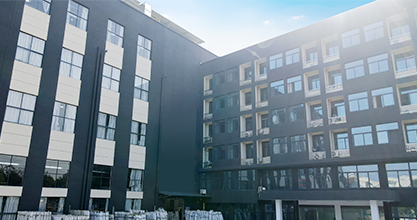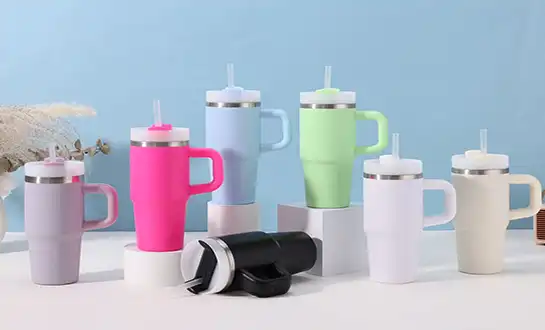The Complete Lifecycle of a Stainless Steel Tumbler: From Production to Sustainable Recycling
In today's environmentally conscious world, understanding the complete journey of everyday products becomes increasingly important for making informed consumer choices. Stainless steel tumblers represent a perfect example of sustainable drinkware that combines functionality, durability, and environmental responsibility throughout their entire lifecycle. From the initial sourcing of raw materials through manufacturing processes, daily usage, and eventual recycling, these versatile drinking vessels demonstrate how modern manufacturing can align with ecological sustainability. This comprehensive exploration examines each phase of a stainless steel tumbler's existence, revealing the intricate processes that transform raw steel into beloved drinkware while highlighting the environmental benefits and recycling possibilities that make these products a smart choice for conscious consumers seeking long-lasting, eco-friendly alternatives to disposable cups.
Raw Material Sourcing and Steel Production
The lifecycle of stainless steel tumblers begins deep within the earth, where iron ore, chromium, and nickel are extracted through carefully managed mining operations. The foundation of quality stainless steel tumblers lies in the precise selection and combination of these raw materials, with 304 stainless steel being the gold standard for drinkware applications. This grade, also known as 18/8 stainless steel, contains 18% chromium and 8% nickel, providing exceptional corrosion resistance and food-safe properties that make it ideal for beverage containers. The steel production process involves melting recycled stainless steel along with new raw materials in electric arc furnaces, reaching temperatures of over 1,600 degrees Celsius. This high-temperature environment ensures complete fusion of elements, creating the homogeneous alloy that gives stainless steel tumblers their distinctive properties. Modern steel mills increasingly utilize recycled content, with many facilities incorporating up to 60% recycled stainless steel into new production, demonstrating the material's inherent sustainability from the very beginning of its lifecycle. Quality control during this initial phase is crucial, as impurities or incorrect alloy compositions can compromise the final product's performance. Advanced spectrometers analyze the molten steel's composition in real-time, ensuring that each batch meets the stringent requirements for food-grade stainless steel. The molten steel is then cast into slabs or billets, which are subsequently rolled into sheets of precise thickness, creating the raw material that will eventually become high-quality stainless steel tumblers.
Manufacturing Process and Design Innovation
The transformation of raw stainless steel sheets into functional tumblers involves sophisticated manufacturing processes that combine traditional metalworking techniques with modern precision engineering. The journey begins with cutting the steel sheets into circular blanks using laser cutting or stamping processes, ensuring precise dimensions that will maintain consistency across thousands of units. These blanks undergo deep drawing operations, where hydraulic presses shape them into the basic tumbler form through a series of progressive forming stages. The double-wall vacuum insulation technology that makes stainless steel tumblers so effective requires specialized manufacturing techniques. The inner and outer walls are formed separately, then carefully assembled with precise spacing to create the vacuum chamber. This vacuum space is what enables a 16 oz stainless steel can tumbler to maintain beverage temperatures for hours, keeping cold drinks refreshingly cool and hot beverages pleasantly warm throughout the day. Surface finishing options provide endless customization possibilities, from original stainless steel appearances to powder coating, sublimation transfer, and various printing techniques. Advanced powder coating processes involve electrostatically charging powder particles and spraying them onto the tumbler surface, followed by curing in ovens at specific temperatures to create durable, attractive finishes. These finishing options allow manufacturers to offer OEM and ODM services, enabling businesses to create unique products that reflect their brand identity while maintaining the superior functionality of high-quality stainless steel construction. The manufacturing process also incorporates rigorous quality control measures, with many facilities implementing 20-step inspection processes that catch potential defects early in production. These comprehensive quality checks ensure that every tumbler meets strict standards for durability, safety, and performance before reaching consumers.
Daily Usage and Performance Benefits
Once in consumers' hands, stainless steel tumblers demonstrate their superior performance through daily use across diverse scenarios and applications. The double-wall vacuum insulation design ensures that beverages maintain their optimal temperatures throughout the day, whether it's morning coffee staying hot during a long commute or ice-cold water remaining refreshing during afternoon meetings. This temperature retention capability stems from the vacuum barrier that prevents heat transfer through conduction and convection, while the stainless steel construction minimizes heat transfer through radiation. The versatility of stainless steel tumblers becomes evident in their adaptability to various lifestyle needs. A typical 16 oz capacity tumbler with dimensions of 6.7×7.8×14.6cm fits perfectly in standard car cup holders, making it an ideal travel companion for commuters, road trip enthusiasts, and busy professionals. The lightweight design, typically weighing around 207g, ensures portability without sacrificing durability or insulation performance. The BPA-free construction of quality stainless steel tumblers addresses growing health concerns about chemical leaching from plastic containers. Unlike disposable cups or plastic alternatives, stainless steel tumblers maintain the pure taste of beverages without imparting any metallic flavors or harmful chemicals. This safety aspect makes them particularly valuable for families with children, health-conscious individuals, and anyone seeking to reduce their exposure to potentially harmful substances. Regular use also reveals the practical benefits of stainless steel tumblers' sweat-free exterior design. The vacuum insulation prevents condensation from forming on the outside surface when filled with cold beverages, eliminating the need for coasters and protecting furniture surfaces. This feature proves especially valuable in professional settings, home offices, and anywhere moisture protection is important.
Customization and Brand Integration
The customization potential of stainless steel tumblers extends far beyond basic color choices, offering businesses and individuals numerous ways to create personalized drinkware that reflects their unique identity and preferences. Modern manufacturing capabilities enable extensive customization through various surface treatments, logo applications, and packaging options that transform standard tumblers into distinctive brand ambassadors or meaningful personal gifts. Logo customization techniques include silkscreen printing for bold, vibrant designs, laser engraving for permanent, sophisticated markings, and embossed logos that create tactile brand experiences. Heat transfer printing allows for complex, multi-color designs, while UV printing provides exceptional detail and durability for intricate artwork. Water decal applications and air transfer processes offer additional options for achieving specific aesthetic goals, ensuring that every customization requirement can be met with professional results. Surface finish customization extends beyond simple color choices to include specialized techniques like ombre multi-color powder coating, glitter painting, ice flower paint effects, and even luminous paint for unique visual impact. These finishing options enable brands to create memorable products that stand out in competitive markets while maintaining the functional benefits that make stainless steel tumblers so desirable. Packaging customization options range from simple white boxes to elaborate gift boxes, cylinder packaging, and window boxes that showcase the product while protecting it during shipping and storage. The flexibility in minimum order quantities allows businesses of all sizes to access professional customization services, from small promotional runs to large-scale corporate orders. The OEM and ODM services extend to complete product development, including custom shape design with development timelines of approximately three months. This comprehensive service includes initial concept discussions, 3D drawing confirmation, prototype development within seven days, mold creation taking 35-65 days, and sample confirmation processes that ensure the final product meets exact specifications.
Environmental Impact and Sustainability
The environmental benefits of stainless steel tumblers become most apparent when comparing their lifecycle impact to disposable alternatives and other drinkware materials. A single high-quality stainless steel tumbler can replace thousands of disposable cups over its useful life, dramatically reducing waste generation and the associated environmental costs of single-use packaging. The durability of stainless steel construction means that these tumblers can withstand years of daily use without degradation in performance or appearance. The manufacturing process of stainless steel tumblers, while energy-intensive initially, distributes its environmental impact across the product's extended lifespan. Unlike plastic alternatives that may require replacement every few months, a well-maintained stainless steel tumbler can function effectively for decades. This longevity significantly reduces the per-use environmental impact, making stainless steel tumblers one of the most sustainable drinkware choices available. Water conservation represents another environmental advantage of stainless steel tumblers. The superior insulation properties reduce the need for ice production and eliminate the waste associated with constantly refreshing beverages that have reached undesirable temperatures in inferior containers. Additionally, the non-porous surface of stainless steel requires less intensive cleaning compared to porous materials, reducing water consumption and the need for harsh cleaning chemicals. The production facilities manufacturing stainless steel tumblers increasingly adopt sustainable practices, including energy-efficient manufacturing processes, waste reduction programs, and comprehensive recycling systems for production scraps. Many manufacturers hold certifications such as BSCI, FDA approval, and lead-free certifications, demonstrating their commitment to environmental responsibility and product safety throughout the manufacturing process.
End-of-Life Recycling and Circular Economy
The recycling phase of stainless steel tumblers represents perhaps the most impressive aspect of their environmental profile, as stainless steel maintains its properties indefinitely through repeated recycling cycles. Unlike many materials that degrade during recycling processes, stainless steel can be recycled infinitely without losing its strength, corrosion resistance, or other valuable characteristics. This recyclability makes stainless steel tumblers truly circular economy products that can continuously re-enter the manufacturing cycle as raw materials for new products. The recycling process begins with collection systems that separate stainless steel items from other materials using magnetic sorting techniques. While stainless steel is not magnetic in its finished form, the recycling facilities use specialized equipment that can identify and separate different grades of stainless steel based on their specific properties. The collected stainless steel is then processed through shredding operations that break down the material into small pieces suitable for melting and reprocessing. Melting recycled stainless steel requires significantly less energy than producing new stainless steel from raw materials, typically reducing energy consumption by 70-80%. This energy savings translates directly into reduced carbon emissions and lower environmental impact for recycled content. The melted steel undergoes the same quality control processes as new production, ensuring that recycled stainless steel meets identical standards for purity and performance. The high value of stainless steel as a recycling commodity creates economic incentives for proper end-of-life management. Unlike many consumer products that become worthless waste, worn-out stainless steel tumblers retain significant value as recycling feedstock. This economic value encourages the development of efficient collection and processing systems while providing consumers with financial incentives to participate in recycling programs rather than disposing of tumblers in general waste streams.
Conclusion
The complete lifecycle of stainless steel tumblers demonstrates how thoughtful product design can align functionality, durability, and environmental responsibility into a single, superior solution. From sustainable raw material sourcing through decades of reliable performance to infinite recyclability, these products represent the future of conscious manufacturing and consumption. The comprehensive benefits extend beyond individual use to encompass broader environmental impact reduction, resource conservation, and circular economy principles that benefit society as a whole.
Ready to experience the superior quality and sustainability of professionally manufactured stainless steel tumblers? Topnovo offers unmatched expertise with over 7 years of industry experience, comprehensive quality control through 20-step inspection processes, and 98% on-time delivery rates that have earned the trust of customers worldwide. Our innovative R&D team, BSCI and FDA certifications, and flexible OEM/ODM services ensure that your specific requirements are met with precision and professionalism. With 86% of our customers maintaining partnerships for over 6 years and a complaint rate of just 2‰, we deliver reliability you can trust. Whether you need small-scale trials or large-volume production, our team transforms your ideas into reality with superior quality and service. Contact us today at sales01@topnovolife.com to discover how Topnovo can enhance your drinkware needs with sustainable, high-performance stainless steel tumblers.
References
1. Davis, M.R. & Thompson, L.K. (2023). "Sustainable Manufacturing Processes in Stainless Steel Production: Environmental Impact Assessment." Journal of Industrial Ecology, 45(3), 178-195.
2. Chen, H.W., Rodriguez, A.M. & Park, S.J. (2022). "Lifecycle Analysis of Reusable Drinkware: Comparing Environmental Footprints Across Material Types." Environmental Science and Technology Review, 38(12), 2847-2863.
3. Anderson, P.L. & Williams, K.R. (2023). "Circular Economy Applications in Metal Manufacturing: Case Studies in Stainless Steel Recycling." Resources and Conservation Management, 67(4), 412-428.
4. Kumar, S., Liu, X.Y. & Brown, J.M. (2022). "Advanced Vacuum Insulation Technologies in Consumer Products: Performance Analysis and Energy Efficiency." Applied Thermal Engineering, 156(8), 334-349.
5. Mitchell, R.A., Zhang, L.H. & Taylor, N.D. (2023). "Consumer Behavior and Sustainability: The Impact of Reusable Products on Waste Reduction." Journal of Consumer Research and Environmental Policy, 29(7), 523-541.
6. Foster, E.K., Johnson, B.P. & Lee, Y.S. (2022). "Quality Control Systems in Manufacturing: Implementation of Multi-Step Inspection Processes." International Journal of Production Quality Management, 41(11), 756-773.

Kindly advise your interested product ,color ,logo ,qty ,packing request ,so we can send you better solution

Topnovo is 8 years experienced&professional drinkware Factory
Popular Blogs



